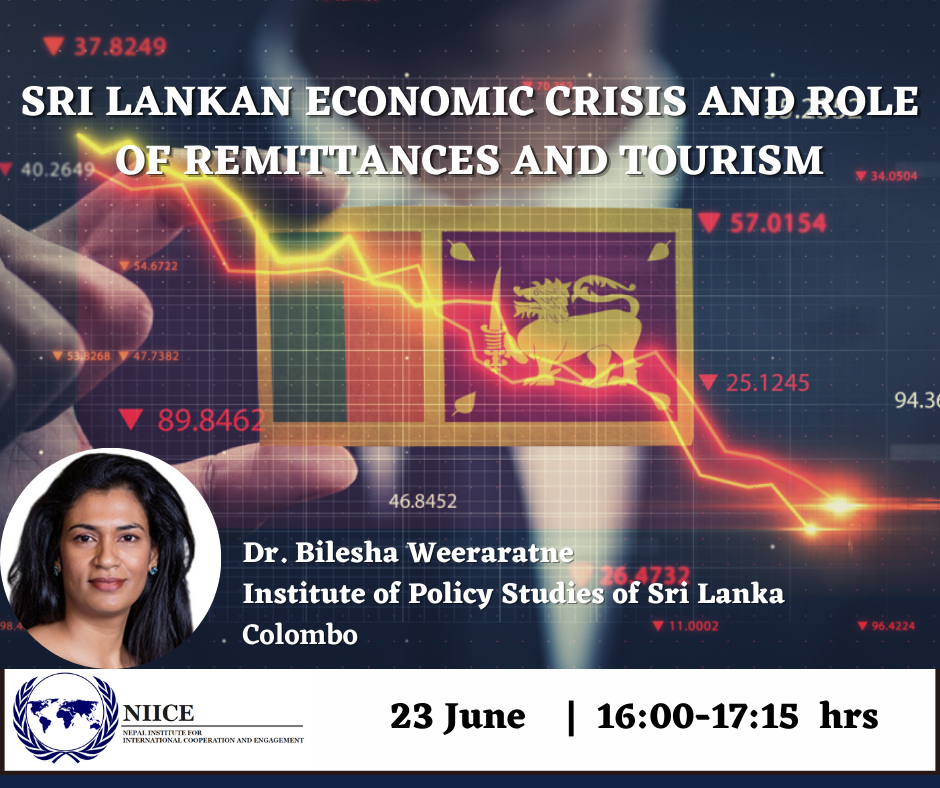
Sri Lankan Economic Crisis and Role of Remittances and Tourism
Watch it on NIICE Nepal YouTube Channel
Event Report
In line with the NIICE Economic Lecture Series, a webinar was held which dealt with the economic crisis occurring in Sri Lanka and the role of remittances and tourism. The topic was presented by Dr. Bilesha Weeraratne, a Research Fellow and Head of Migration and Urbanization Research at the Institute of Policy Studies of Sri Lanka. Dr. Weeraratne discussed the shocks to the Sri Lankan economy which already had deep issues and the role of remittances and tourism in the solution for the crisis. She started with a walkthrough of the chronological order of what happened in Sri Lanka.
Dr. Weeraratne started by discussing the situation before and after the two specific shocks in 2019 and 2020. In 2018, Sri Lanka experienced a good economic year. The country received over USD 7 billion in remittances, accounting to 8 percent of the USD 88 billion GDP and is the highest foreign exchange earner. Tourism earned about USD 4.4 billion, accounting to 5 percent of the GDP and is the third highest foreign exchange earner which also provided a large amount of employment opportunities. The first quarter of 2019 recorded the highest number of arrivals, averaging at 7, 600 arrivals per day. But then, two specific shocks came, the Easter Attack and the COVID-19 pandemic. After the Easter Attack, there were 80 percent cancellations, new bookings declined rapidly, arrival numbers dropped to 1, 700 per day and earnings declined by 17.7 percent. Although tourism was at a good level by January, which slid in February mainly due to seasonality, COVID-19 affected the arrivals. Sri Lanka closed its borders from foreign tourists by March 2018 and direct and indirect employment went down. Remittances used to range around USD 7 billion a year but in 2020 it declined, plunging into an all-time low at April. It picked up after and 2020 recorded a positive growth in remittances due to switching from informal to formal channels and remittances being countercyclical.
Dr. Weeraratne then looked into the deep-rooted economic issues which contributed to the ongoing economic crisis. One was poor macroeconomic fundamentals in which Sri Lanka was running heavy fiscal deficits. Another is the big tax cut by the incumbent government in November 2019. Then much of the heavy boom for investment and economic growth after the Thirty Year War was characterized by heavy borrowing from capital markets, issuing of sovereign bonds, and reaching out to new lenders which went into public investment but had little return and little capacity to repay. Because of these, the Sri Lankan economy could not cushion itself after the two shocks. Another thing that contributed to the deep economic issues is the decision to ban chemical fertilizers for some reason which backfired and lowered crop yield, resulting in lower food security. Along with these, there was a need for continuous money printing which led to building up inflationary pressures. Sri Lanka lacked in energy security by a heavy reliance on importation, even for essential items. There were also currency concerns with depreciating, the emergence of parallel foreign exchange markets, the hesitation for remitters to send money through formal channels and a decline in the tourism sector in 2021.
Dr. Weeraratne proceeded to talk about the ongoing economic crisis. There are severe shortages on gas for transportation and cooking, a shortage of fertilizer which resulted in less crops, significant food shortage, unbearable daily power cuts up to 12 to 13 hours a day, increase in days off, children missing many days of school, frequent protests, massive exchange rate currency depreciation and rampant inflation amidst the global prices rising due to the geopolitical tension. In 2022, Sri Lanka defaulted external debt. The country is trying to restructure their debt with help from the International Monetary Fund (IMF) and is receiving international aid from other countries and international organizations. The exchange rate depreciated, but it regained stability after changing the Central Bank of Sri Lanka (CBSL) governor and new monetary policy mechanisms were introduced. There is an increase in migrant departures but remittances are coming in slow. An interesting phenomenon happened wherein migrant households are not as impacted by the crisis as to non-migrant households due to informal channels of remittances being countercyclical while the formal channels have become procyclical. It is a signal from the migrant workers reflecting their displeasure. Without formal remittances, there are no funds for essential imports and more depreciation pressure ensues.
To conclude, the solutions provided by Dr. Weeraratne are to increase formal remittances, handle informal remittances and do concrete changes in the country to revive tourism. Migration numbers have to be pushed up to increase remittances by looking into new markets and new skills and providing funds and support to facilitate their recruitment, alongside various proposals that incentivize the increase of remittance. The government has to tactfully handle diverting informal remittance to formal by not creating too many regulations that would lead to more informality. Concrete changes need to happen to increase tourist arrival and reverse negative travel advisories.
Prepared by Patricia Bianca D. Aguilar, Research Intern at NIICE.

Recent Comments